











Berlioz - Symphonie Fantastique - Seiji Ozawa and The Boston Symphony Orchestra
ORDER LIMITED TO ONE ITEM PER CUSTOMER
Hector Berlioz - Symphonie fantastique: Épisode de la vie d'un artiste… en cinq parties (Fantastical Symphony: Episode in the Life of an Artist… in Five Sections) Op. 14
Chorus – New England Conservatory Chorus
Chorus Master – Lorna Cooke deVaron
Boston Symphony Orchestra
Conductor – Seiji Ozawa
1 LP, Gatefold jacket
Limited to 3,000 numbered copies
Original analog Master tape : YES
Heavy Press : 180g Virgin Vinyl
Record color : black
Speed : 33 RPM
Size : 12'’
Stereo
Studio
Record Press : Optimal Media GmbH in Germany
Label : Deutsche Grammophon - The Original Source series
Original Label : Deutsche Grammophon
Recorded at the Symphony Hall, Boston USA in February 1973
Engineered by Hans-Peter Schweigmann
Recording Supervisor – Thomas Mowrey
Produced by Thomas Mowrey
Mixed by Rainer Maillard
Mixed and mastered at Emil Berliner Studios
Photography by Claus Hennch
Design by Lutz Bode
Sleeve Notes by Eric Salzman, Heinz Becker
Originally released in 1973
Reissued in September 2023
Tracks:
Side A:
- Rêveries - Passions (Dreams - Passions / Traumereien - Leidenschaften) - Largo - Allegro agitato e appassionato assai
- Un bal (A Ball - Ein Ball) - Valse: Allegro non troppo
Side B:
- Scène aux champs (Country Scene - Szene auf dem Lande) - Adagio
- Marche au supplice (March to teh Scaffold / Der gang zum Richtplatz) - Allegretto non troppo
- Songe d'une nuit du Sabbat (Dream of a Witches' Sabbath / Beim Hexensabbat) - Larghetto - Allegro - Ronde du Sabbat
Reviews :
“The Boston Symphony play for Ozawa as they did for Munch, that is with flair and commitment from each section. The surround-sound is clean and satisfying, despite being now more than forty years old. The first movement’s largo opening is evocatively done, expressive in its response to the detailed markings but it is still slightly classical in feeling. It reminds us that Berlioz’s gods were Gluck, Beethoven and Weber, and that his champion Liszt’s innovations lie a long way ahead. Perhaps though the last piu animato could have a touch more abandon. There is no exposition repeat.
The ball scene dances gaily, and there is a nice presence to the important harp parts and good balance when the idée fixe waltzes onto the scene. I do though miss the cornet part here which most conductors of the era – and since – omit. The slow movement is very successful in its chaste way, from a fine cor anglais at the start to a poetic coda, though with the timpani’s distant thunder fractionally closer than some. The bassoons chortle grimly in the march to the scaffold and the Boston brass are terrific here and again in the finale, which has very tangible bells. Overall this is an excellent mainstream interpretation, one of the best of its time and viable still. » Musicweb International Review by Roy Westbrook
Ratings :
Discogs : 4.91 / 5



